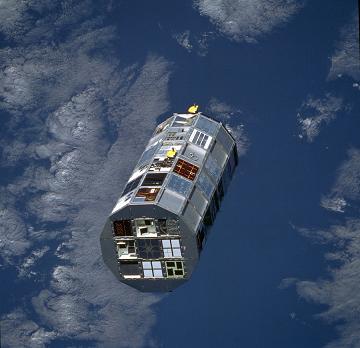As the primary cause of concern from space debris is physical damage upon impact, extensive efforts have been made for their detection. There are several detection methods, and they are grouped into two classes: active and passive.
Radar sensors fall into the first class, and radio interferometers and optical sensors in the second. One important element that has to be considered is the accuracy of the method used for detection.
The motion of an object in Earth orbit is completely determined if the so-called orbital elements are known. In theory, the orbital elements of a satellite can be calculated from only one observation. In practice, due to inherent observation errors, there is more than one observation needed to attain the precision required for orbital surveillance and prediction. Some 100-200 observations are required during the first days of orbit, 20-50 observations per day to update established orbits, and 200-300 observations per day to confirm and locate reentry in the case of decaying orbits.
In addition, the size of the debris is an important factor that affects the accuracy of the detection methods, and this is why only a small fraction of the space debris population is detectable, and as a consequence, catalogued. For example, present equipment is capable of tracking only objects bigger than 5 cm in diameter in low Earth orbit (altitudes of 160-2,000 km), and bigger than 50 cm in diameter in geosynchronous orbit (altitudes of 35,000 km). Further, the characteristics of certain type of orbits can make detection very difficult. For example, the debris population generated on highly elliptical and high inclination orbits with perigees situated deep in the Southern Hemisphere, also known as Molniya orbits, is very difficult to track. The geographic location of the ground stations used for space debris tracking makes detection impossible.
For these reasons, out of an estimated debris population of 600,000 objects bigger than 1 cm in diameter, only 19,000 can be tracked as of today.
The measurement and detection methods mentioned above are all remote methods. In-situ measurements of the characteristics of the debris environment have been conducted as well. In April 1984, the Space Shuttle Challenger placed into low Earth orbit a NASA spacecraft carrying a number of experiments for the purpose of characterizing the low Earth orbit environment. The spacecraft, the Long Duration Exposure Facility (LDEF), was a twelve-sided cylindrical structure and three-axis stabilized in order to ensure an accurate environmental exposure, and was supposed to spend one full year in orbit. Before the planned retrieval, the Space Shuttle fleet was grounded as a result of the Challenger accident on January 28, 1986. Eventually, the exposed facility was returned to Earth by the Space Shuttle Columbia during a mission in January 1990. After the extended mission, the results of the onboard experiments facilitated to a greater extent the understanding of the interactions between artificial objects and the space debris environment in Earth orbit as numerous impact craters were found on the outer layers of the spacecraft and analyzed.
In-situ measurements of the characteristics of the space debris environment have also been conducted by the European Retrievable Carrier (EURECA) and the Space Flyer Unit (SFU).










 Subscribe to our RSS feed
Subscribe to our RSS feed











There are no comments.
Add A Comment